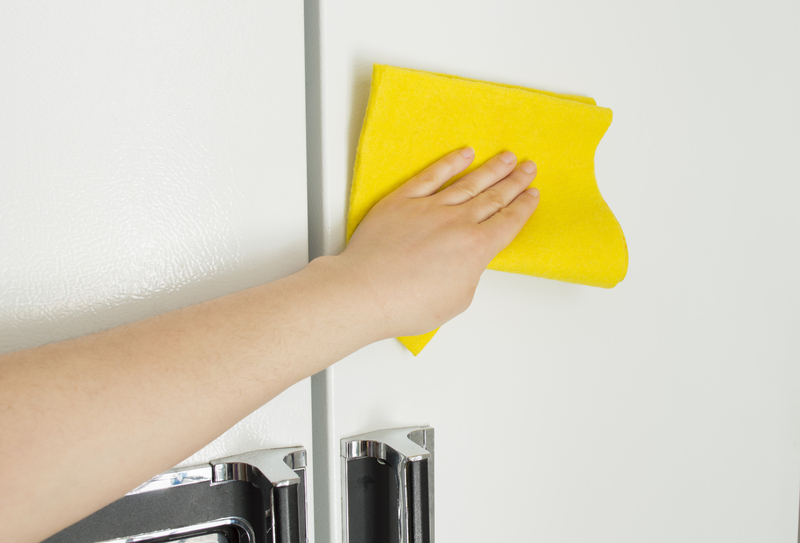Achieve Spotless Window Sills by Bidding Goodbye to Mould
Posted on 16/09/2025
Achieve Spotless Window Sills by Bidding Goodbye to Mould
Are you plagued by unsightly mould on your window sills? It's time to restore a sparkling, healthy look to your home. Discover comprehensive tips and effective methods to achieve spotless window sills by saying goodbye to mould--forever.
Understanding Why Mould Grows on Window Sills
Mould isn't just an eyesore; it's a problem that can affect your health and the value of your home. Window sills are popular breeding grounds for mould because of constant exposure to condensation, humidity, and sometimes leaky windows.
- Moisture: The primary cause of mould is excess moisture. Condensation gathers on window panes and seeps down onto the sills.
- Poor Ventilation: Lack of air circulation creates a humid microclimate, ideal for mould spores.
- Organic Debris: Dust, dirt, and pollen accumulating on your sills provide nutrients for mould to thrive.
- Leaky Windows: Gaps and cracks let rainwater inside, increasing dampness.
Why You Should Act Fast Against Mould
Mould is more than just unpleasant to look at. Prolonged mould exposure can cause allergies, asthma, and even aggravate respiratory conditions. Its unsightly presence can also damage wooden sills, paint, and window frames, leading to expensive repairs down the line.
- Health Impact: Persistent mould can trigger sneezing, coughing, eye irritation, and other allergic reactions.
- Property Damage: Over time, mould destroys paint, leads to wood rot, and can even undermine the structural integrity of your window frames.
- Odour: Mould produces a musty smell that makes rooms feel unwelcoming.
- Aesthetic Concerns: Black, green, or brown patches lower the aesthetic appeal of your house.

Expert Techniques for Cleaning Mould from Window Sills
Ready to take action? Here are top-rated, effective ways to clean mould from window sills and prevent regrowth. Each method below helps you achieve spotless window sills safely and efficiently.
1. Gather the Right Supplies
- Protective gloves and mask
- Bucket of warm water and mild soap
- Microfiber cloths or sponges
- Soft-bristled brush or old toothbrush
- White vinegar or hydrogen peroxide
- Baking soda (optional)
- Spray bottle
- Paper towels
- Small paint scraper (for stubborn mould)
- Moisture absorber or dehumidifier
2. Safety First!
Before you tackle mould, wear gloves and a mask to avoid breathing in spores. Open windows in the room for proper ventilation during cleaning.
3. Remove Excess Moisture
- Use a dry cloth to soak up visible condensation or puddles on sills.
- If possible, use a handheld vacuum with a HEPA filter to remove loose spores and dust.
4. Clean Window Sills with Soap and Water
- Mix warm water with a few drops of dish soap in a bucket.
- Dampen a microfiber cloth and gently wipe the entire sill to remove surface grime and initial mould layers.
- Pay attention to joints and grooves using a soft brush or old toothbrush.
5. Treat Mould with Natural Cleaners
For persistent mould, natural solutions are often eco-friendly and safe for most surfaces.
- White Vinegar: Pour undiluted white vinegar into a spray bottle. Liberally spray over the mouldy areas, let it sit for an hour, then scrub away with your brush or cloth. Wipe with a clean damp cloth.
- Hydrogen Peroxide (3%): Spray onto mould patches, wait 15 minutes, then wipe clean.
- Baking Soda: For tough stains, make a paste of baking soda and water, apply to the area, let sit, scrub gently, and rinse off.
Do not mix cleaning products together as this can create dangerous fumes.
6. Rinse and Dry Thoroughly
- After cleaning, wipe window sills with a damp cloth to remove any cleaning residues.
- Use a dry towel or paper towels to dry the area completely. A dry surface helps prevent future mould outbreaks.
7. Repair and Prevent Future Damage
- Check for leaks and seal cracks around the window that can let in water.
- Repaint or seal your window sills with mould-resistant finishes for additional protection.
- Use a dehumidifier or moisture absorber to lower indoor humidity, especially in winter or in poorly ventilated rooms.
- Use weather stripping around windows to prevent water ingress.
Tips for Preventing Mould on Window Sills
Your spotless window sills remain pristine only with ongoing prevention. Adopt these easy tips to get rid of window sill mould and stop future outbreaks:
- Ventilate daily: Open windows or use extractor fans to let out humid air, especially after cooking or showering.
- Wipe condensation: Make it a habit to wipe off excess condensation every morning in cold weather.
- Keep curtains and blinds open: Sunlight inhibits mould growth. Let sunlight reach window sills for several hours daily if possible.
- Maintain a dry environment: Use dehumidifiers in damp rooms, especially bathrooms and kitchens.
- Regular cleaning: Dust and clean sills often to remove food for mould--such as dust and pollen.
- Inspect frames: Look out for signs of rot or leaks and fix promptly.
- Use anti-mould sprays: After cleaning, apply a store-bought anti-mould spray for lasting defence (follow manufacturer instructions).
Consistent prevention ensures your window sills stay spotless and fresh year-round!
Best Practices for Different Window Sill Materials
The best mould removal method depends on your sill material. Using the correct technique ensures thorough cleaning without damage.
Wooden Window Sills
- Wipe only with slightly damp (not wet) cloths to prevent swelling.
- Avoid soaking or using excessive water-based cleaners.
- If paint is flaking due to mould, sand gently and repaint with a mould-resistant paint or varnish.
- Repair cracks or gaps with wood filler before cleaning to prevent water ingress.
uPVC or Vinyl Window Sills
- Safe to wash thoroughly with soapy water and scrub gently.
- Use baking soda paste for stubborn stains but avoid abrasive pads.
- Finish with a light spray of vinegar or hydrogen peroxide for extra protection.
Stone or Marble Sills
- Clean using a pH-neutral cleaner--acidic solutions like vinegar may etch stone surfaces.
- Wipe dry to prevent streaks and mineral spots.
- Apply a stone-safe anti-mould treatment for best preventive care.
When to Call a Professional
In some cases, mould contamination may be too extensive or persistent for DIY approaches. Call a professional if:
- Mould covers an area larger than 1m? (about 3 feet by 3 feet).
- You experience repeated outbreaks despite regular cleaning.
- There are signs of structural damage or soft, rotting wood.
- You have underlying health conditions such as allergies, asthma, or immune system challenges.
Experienced mould remediation specialists have the right tools and expertise to resolve severe infestations safely and thoroughly.
Eco-Friendly Ways to Achieve Spotless Window Sills
If you want to get rid of mould on your window sills without harsh chemicals, try these green alternatives:
- Tea tree oil: Add 1 teaspoon of pure tea tree oil to 1 cup of water. Spray, let it sit, then scrub and rinse. It's a powerful natural fungicide.
- Lemon juice: Lemon's natural acidity works well on light mould stains. Combine with salt for gentle scrubbing.
- Grapefruit seed extract: Add 10 drops to about 1 cup of water. Spray and leave it--no need to rinse off!
These eco-friendly cleaning methods are gentle on your home and the environment, helping you achieve spotless mould-free window sills naturally.

Frequently Asked Questions About Mould on Window Sills
-
Is mould on window sills dangerous?
Some mould species release spores and toxins that trigger health issues, especially for those with allergies or asthma. It's best to remove mould promptly and take steps to prevent its return. -
Can black mould on window sills be removed permanently?
It is possible with diligent cleaning, repairs, and consistent moisture control. Address leaks and keep window areas dry for long-lasting results. -
Should I replace my window sills if mould returns often?
If your sills are rotten or structurally compromised, replacement may be necessary. Otherwise, focus on better sealing, cleaning, and ventilation first. -
What's the fastest way to get rid of mould on a window sill?
Wipe away surface mould with soapy water, then treat remaining spots with white vinegar or hydrogen peroxide. Always dry the area thoroughly after cleaning for fast, effective results.
Conclusion: Say Goodbye to Mould and Hello to Sparkling Window Sills
If you want your window sills spotless and free from harmful mould, the key is quick action and ongoing prevention. Follow these expert cleaning methods, adapt them for your window materials, and commit to a regular maintenance routine. With these practical tips, you can finally achieve spotless window sills by bidding goodbye to mould--leaving your home cleaner, healthier and more beautiful than ever!
Make mould a thing of the past and rediscover the joy of sparkling, fresh window sills with these helpful strategies. Your home--and your health--will thank you!




